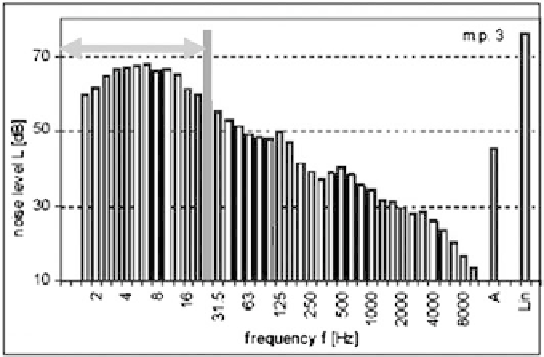Environmental Engineering Reference
In-Depth Information
Considering the nature of infrasound, it becomes apparent that downwind wind
turbines are more likely to produce signifi cant levels of infrasound levels. This is
because the tower-blade fl ow interaction creates air velocity instabilities that pro-
duce very low frequency acoustic waves called infrasound. Although downwind
wind turbines have been used in the past, the modern technology has moved away
from that noisy design to the upwind designs that give higher frequency noise
levels and therefore are less irritating for humans.
One example of low frequency sound and infrasound from a modern turbine is
shown in Fig. 3.
Broadband noise is dominated by high frequencies greater than 100 Hz and it is
characterised by non-periodic signals that constitute an envelope that varies peri-
odically. A typical broadband signal is shown in Fig. 4. Its main source of genera-
tion is the interaction of the wind turbine blades with atmospheric turbulence, and
also described as a characteristic "swishing" or "whooshing" sound.
To determine the relative importance of tone noise and broadband noise we
consider the narrow-band frequency spectrum of a signal. Figure 5 shows a typical
spectrum of tonal and broadband noise. At higher frequencies the broadband
random noise dominates the spectrum.
2.3 Mechanical generation of sound
A wind turbine consists of mechanical components that move or rotate in order to
capture the motion of the turbine and convert it to energy. Sources of such sounds
include:
1.
Gearbox
2.
Generator
3.
Yaw drives
4.
Cooling fans
5.
Auxiliary equipment (e.g. hydraulics)
Figure 3: Infrasound [ 2 ].

Search WWH ::

Custom Search